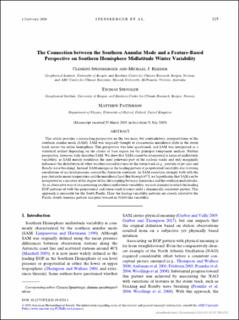| dc.description.abstract | This article provides a reconciling perspective on the two main, but contradictory, interpretations of the southern annular mode (SAM). SAM was originally thought to characterize meridional shifts in the storm track across the entire hemisphere. This perspective was later questioned, and SAM was interpreted as a statistical artifact depending on the choice of base region for the principal component analysis. Neither perspective, however, fully describes SAM. We show that SAM cannot be interpreted in terms of midlatitude variability, as SAM merely modulates the most poleward part of the cyclone tracks and only marginally influences the distribution of other weather-related features of the storm track (e.g., position of jet axes and Rossby wave breaking). Instead, SAM emerges as the leading pattern of geopotential variability due to strong correlations of sea level pressure around the Antarctic continent. As SAM correlates strongly both with the pan-Antarctic mean temperature and the meridional heat flux through 65°S, we hypothesize that SAM can be interpreted as a measure of the degree of the (de)coupling between Antarctica and the southern midlatitudes. As an alternative way of characterizing southern midlatitude variability, we seek domains in which the leading EOF patterns of both the geopotential and storm-track features yield a dynamically consistent picture. This approach is successful for the South Pacific. Here the leading variability patterns are closely related to the Pacific–South America pattern and point toward an NAO-like variability. | en_US |
